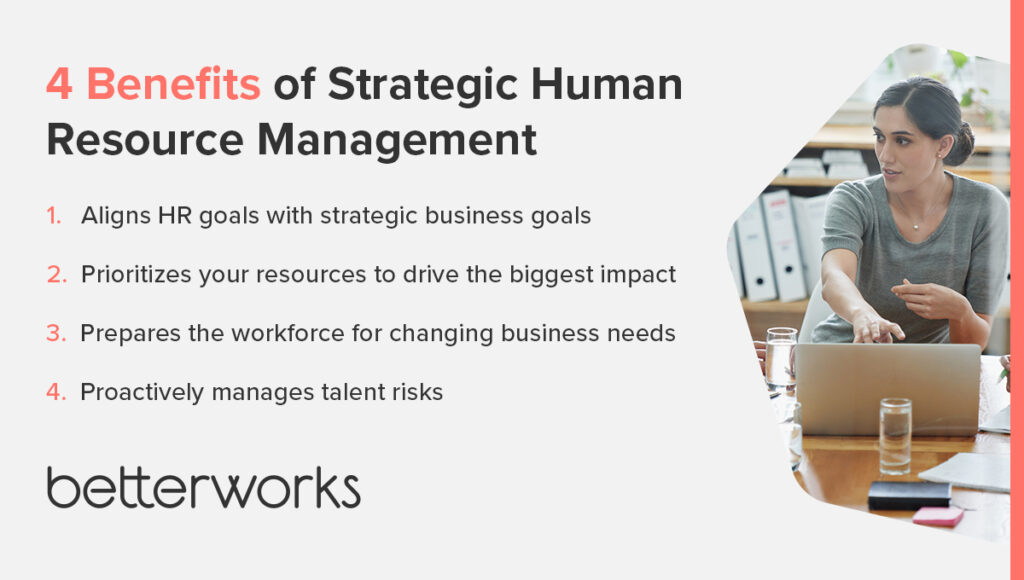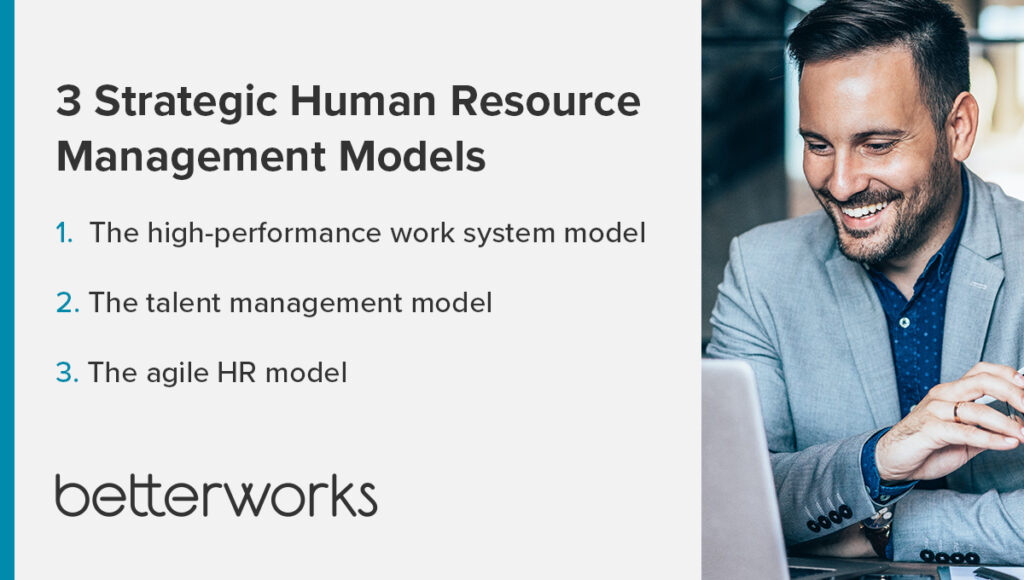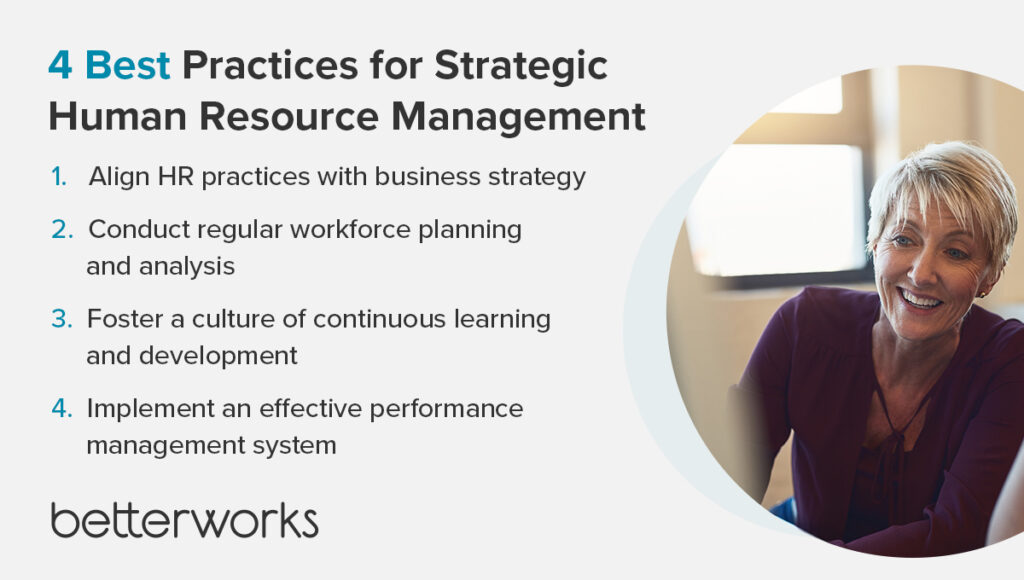- What is strategic human resource management, and why does it matter?
- How technology such as data analytics and AI affect strategic human resource management
- 3 examples of strategic human resource management models
- 4 best practices for implementing a strategic human resource management process
- How Betterworks supports strategic human resource management
- Fuel a successful future
HR plays an increasingly important role in driving sustainable growth and competitive advantage in a challenging business climate. Strategic human resource management is a powerful framework that aligns HR practices with organizational goals, enabling you to unleash your workforce’s full potential and achieve better business outcomes.
Learn what strategic human resource management is, how it supports the business strategy, and how to implement a more strategic approach in your organization.
What is strategic human resource management, and why does it matter?
In the context of human resources, strategic management is the process of aligning your HR strategy and goals with the broader business strategy to make the best use of the talent, skills, and abilities present in your workforce. It uses long-term scenario planning to ensure your workforce has the right talent, skills, and competencies to execute an evolving business plan and meet future challenges.
Strategic HR management overlaps with every HR process, from attracting and retaining employees to performance management and long-term training and development. If one of your business goals is to respond to changing market demands, for instance, HR programs related to internal mobility (like a talent marketplace) can help team members build skills that can help them become more agile and responsive.
Check out some of the top benefits of applying strategic human resource management in your HR department.
Aligns HR goals with strategic business goals
By aligning your HR goals with business goals, strategic human resource management creates a cohesive, integrated approach to managing human capital. It helps you make better plans to attract, develop, and keep the right people to carry out the larger strategic vision.
If one of the business’s top goals is to expand into new markets, for instance, a parallel strategic HR goal might be to build a leadership pipeline. Developing a strong leadership pipeline now sets up the business with capable future leaders who can effectively drive growth and navigate the complexities of entering new markets. These leaders can spearhead strategic initiatives, make informed decisions, and inspire and motivate teams to achieve business goals.
Prioritizes your resources to drive the biggest impact
Strategic human resource management identifies the key skills and competencies your workforce needs to execute the business plan successfully. Part of the strategic human resource management process is to conduct a thorough analysis of the organization’s current and future talent needs to determine the skills that will have the greatest impact on achieving business goals.
Equipped with that knowledge, you can make informed decisions about reinforcing the skills you currently have, reskilling and upskilling the workforce to fill gaps, hiring for skills, or outsourcing the skills you don’t need to build in-house.
Prepares the workforce for changing business needs
In today’s rapidly evolving business landscape, organizations need to adapt quickly to market changes, technological advancements, and shifting customer demands. Strategic human resource management requires a deep understanding and regular assessment of the business strategy to understand the organization’s changing needs and adapt your plan to keep up.
A strategic approach to human resource management helps you develop a comprehensive workforce planning strategy to ensure you have the right talent in place to meet the changing demands of the business strategy. It allows you to implement talent development programs, such as training, upskilling, and reskilling programs, or career coaching, to equip employees with the necessary skills and knowledge to support ongoing change.
Contributes to cost-savings and efficiency
Strategic human resource management enables businesses to optimize their workforce planning and talent management processes. By forecasting future talent needs and developing strategies to attract, develop, and keep top talent, you can reduce recruitment costs, minimize turnover, and improve employee productivity.
Additionally, strategic human resource management streamlines HR processes and systems by using technology to automate administrative tasks, which reduces manual effort and increases efficiency. It also deploys effective people analytics and data-driven decision-making processes, letting you identify cost-saving opportunities and further optimize your resource allocation.
Recommended read: People Analytics Strategy: 12 Practices to Strengthen Your HR
Proactively manages talent risks
There are always risks associated with attracting, developing, and keeping the talent you need to meet your business goals. Strategic human resource management helps you overcome talent risks by conducting thorough talent assessments and identifying potential gaps in skills, competencies, and leadership capabilities that could interfere with your strategic business plan.
This includes proactively managing employee retention, for instance, to ensure the people you’ve invested in developing remain happy, engaged, and productive. Managing talent risks helps to minimize disruptions, maintain a positive work environment, and ensure legal and regulatory compliance.

How technology such as data analytics and AI affect strategic human resource management
Data analytics and AI tools have a significant impact on strategic human resource management. These tools can help you make data-driven decisions, automate processes, and enhance your human resource department’s overall effectiveness. AI-enhanced tools help HR professionals collect, analyze, and interpret vast amounts of data related to employee performance, engagement, and productivity. This data-driven approach lets you identify trends, patterns, and insights that can inform strategic decision-making.
Using predictive analytics, you can compare the skills required to carry out the business plan with the skills your workforce currently has to find skills gaps you need to fill. This analysis allows you to prioritize areas for skill development and create targeted training programs or initiatives.
Furthermore, data analytics tools enable you to measure and track key performance indicators (KPIs) related to workforce planning, talent management, and employee engagement. Access to robust analytics, such as that from a performance management solution, allows you to drill down into data specifics to reveal patterns and trends. These give you fresh insights into the underlying sources of things like low or high performance, turnover, manager effectiveness, and engagement levels. These analytics help HR assess the effectiveness of strategic human resource management plans and make data-backed adjustments as needed.
Generative AI can be a game-changer for your strategic human resource management process, too. Reskilling and upskilling are key elements of workforce planning, but you need employees to want to learn new skills before they’ll engage in those programs. Using generative AI for HR, you can help managers and employees write goals that align their personal career tracks with what the business needs to move its plan forward.
The more you can bring advanced data analytics and AI tools into your strategic human resource management process, the easier it will be to empower each employee across the organization to carry out the strategic business plan.
3 examples of strategic human resource management models
Your strategic human resource management plan can take a lot of different routes. The model you choose depends on what your business needs most. Here are a few examples of models you might use and when to use them to drive the biggest impact.
The high-performance work system model
This strategic human resource management model focuses on creating a work environment that fosters high performance through improved HR practices. This model emphasizes increasing employee autonomy, promoting loyalty, and creating a culture of continuous learning and growth.
The model promotes employee involvement in decision-making processes and encourages employees to take ownership of their work. It recognizes the value of empowering employees to contribute their ideas, suggestions, and expertise to improve organizational performance. It focuses on aligning individual goals with business objectives and providing employees with the necessary support and resources to achieve high levels of performance.
Employers use this model to enhance engagement, drive productivity, and promote a competitive advantage in the market. This model would be most useful for employers looking to double down on both their employer and consumer brands to stand out in a crowded market.
The talent management model
The talent management model of strategic human resource management focuses on attracting, developing, and keeping top talent within the organization. It involves identifying critical roles and competencies required for success, implementing effective processes to fill those gaps through an external labor market, and providing targeted growth opportunities for the current workforce.
The talent management model emphasizes key HR functional programs, such as succession planning, career development, and performance management to ensure a pipeline of skilled and capable employees.
Employers who use this model aim to build a strong talent pool, reduce turnover, and ensure a sustainable workforce that has the skills and competencies needed to drive the company’s long-term success. It’s a basic strategic model that employers reworking their HR strategy and processes would benefit most from using.
The agile HR model
This strategic human resource management model aligns HR practices with the principles of agility initially pioneered in the technology sector. It focuses on creating a flexible and responsive HR function that can quickly adapt to changing business needs and market dynamics.
The agile model of human resource management emphasizes cross-functional collaboration, iterative decision-making, and continuous improvement. It involves implementing agile practices such as scrum teams, sprints, and regular feedback loops to enhance HR processes such as recruitment, performance management, and learning and development.
Employers who adopt this model intend to increase workplace agility, innovation, and the ability to navigate complex and uncertain business environments. It’s most helpful for companies that are in transition or breaking into new markets.

4 best practices for implementing a strategic human resource management process
Implementing a strategic human resource management process requires careful planning and execution. Here are some best practices to help you keep your strategy on target and drive value to the business.
Align HR practices with business strategy
Make sure that all of your HR programs, such as talent acquisition, performance management, and training, are directly linked to the strategic goals and business plan. This alignment ensures that HR efforts contribute to the overall success of the business.
Achieving alignment with the business starts with knowledge of the business plan, including the industry landscape, competitive challenges, and future growth plans. Once the leadership team is aligned on where to take the business, you can shape your human resource management strategy to support those goals.
HR metrics play a crucial role in aligning HR programs with the business strategy. By measuring and tracking relevant HR metrics, such as employee turnover and training effectiveness, you can assess the impact of HR programs on the business plan.
Conduct regular workforce planning and analysis
Continuously assess the organization’s current and future workforce needs to identify any gaps or surpluses in talent. This analysis helps in developing strategies for recruitment, succession planning, and talent development to ensure the availability of the right skills at the right time.
Anticipate the business’ future needs based on its strategic goals and industry trends. Determine the skills, knowledge, and capabilities the workforce will need to achieve those goals. Establish key workforce metrics to track and measure the effectiveness of the workforce planning and analysis efforts.
Workforce planning is an ongoing process. Regularly review and update the workforce plan to make sure it remains aligned with the changing needs of the business and the external environment. This may involve revisiting the workforce plan, updating your strategy, or reallocating resources to address emerging needs or challenges.
Foster a culture of continuous learning and development
Continuous growth is a key element of strategic human resource management. Evolving the workforce to sustain a changing business plan helps you unlock the full potential of each person in the organization.
Create an environment where learning is valued and encouraged. Recognize and reward employees who actively engage in learning and development activities. Encourage knowledge sharing and collaboration among employees to facilitate continuous learning.
Encourage team members to create individual employee development plans that outline their learning goals and aspirations. Provide guidance and support in identifying relevant learning opportunities and resources to help employees achieve their development objectives. Encourage them to seek out learning opportunities, explore new skills, and take initiative in their professional growth.
Integrate learning and development goals and objectives into the performance management process. Regularly discuss employees’ learning progress and provide feedback on their development and skill-building efforts. Link learning outcomes to performance evaluations and help team members see how their growth drives business value.
Implement an effective performance management system
A great performance management process drives the business forward by aligning individual goals with the larger business plan. Equip managers to help their teams see the value they deliver to the business simply by achieving their own goals.
Clearly communicate performance expectations to employees, including goals, objectives, and key performance indicators. Make sure employees understand what their managers expect of them and how their performance will be evaluated.
Implement a system that encourages ongoing feedback and communication between managers and employees. Provide opportunities for both formal and informal feedback, such as regular check-ins with their managers and feedback crowdsourced from colleagues.
Ensure that individual performance goals are aligned with the overall organizational goals and objectives. This helps employees understand how their work contributes to the success of the business and fosters a sense of purpose and alignment.

How Betterworks supports strategic human resource management
Betterworks supports strategic human resource management by providing a comprehensive intelligent performance management platform that aligns employee goals with the organization’s strategic objectives. The platform enables HR professionals to set clear and measurable goals, track progress, and provide continuous feedback and coaching to employees. By aligning individual goals with the overall business strategy, Betterworks helps you ensure that every employee’s efforts contribute to delivering value and results.
Betterworks also facilitates ongoing performance conversations and check-ins, fostering a culture of continuous improvement and development. This allows HR to proactively manage employee performance, identify areas for growth, and provide timely support and recognition. The platform’s data analytics capabilities provide valuable insights into employee performance trends, helping HR make informed decisions about talent development, succession planning, and resource allocation.
Fuel a successful future
Strategic human resource management involves a proactive approach to talent management, workforce planning, learning and development, performance management, and employee engagement. It requires HR professionals to be strategic partners, working closely with leaders and stakeholders to ensure that the organization has the right people, with the right skills, in the right positions, at the right time.
By embracing strategic human resource management, you can create a culture of excellence, innovation, and continuous improvement that positions your company for long-term success in today’s dynamic and competitive business environment.
Want to learn more? Discover how to develop your own HRM plan.







